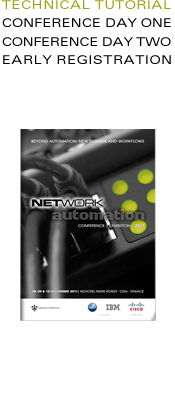|
|
| |
|
|
| |
|
|
|
|
|
| |
| |
 |
 |
| |
|
|
An introduction to NETCONF and YANG |
|
| |
|
|
|
|
| |
|
|
Presented by STEFAN WALLIN, Tail-F |
|
| |
|
|
|
|
| |
|
09.00 |
WELCOME, REGISTRATION AND COFFEE |
|
| |
|
|
|
|
| |
|
09.30 |
Netconf and YANG |
|
| |
|
|
What is Netconf?
What is YANG?
Netconf Architecture |
|
| |
|
10.30 |
COFFEE BREAK |
|
| |
|
11.00 |
YANG
|
|
| |
|
|
Data models in YANG
Comparison to SNMP/MIBs |
|
| |
|
12.00 |
LUNCH |
|
| |
|
14.00 |
Use Cases |
|
| |
|
|
Network transactions
Device backup
Configuration rollback
Configuration validation
On Device Validation
Implementing Guardrails
A simple example and demo
Conclusions
Summary
|
|
| |
|
15.00 |
COFFEE BREAK |
|
| |
|
15.30 |
Scenarios of an Automation Solution |
|
| |
|
|
|
|
| |
|
|
Presented by
Marisol Palmero, Hanlin Fang, Jason Pfeifer, and Joe Clarke, Cisco |
|
| |
|
|
|
|
| |
|
|
Covering best practices for leveraging Cisco's embedded automation features with attention paid to EEM, IP SLA, and NetFlow.
Leveraging the best practices in use cases highlighting video deployment and performance troubleshooting.
Showing how to package this use case using Cisco's Embedded Automation System's package mechanism to facilitate the configuration of IP SLA, Medianet Performance Monitor, and Embedded Event Manager parameters.
Exploring ways of integrating the output of the troubleshooting solution with Tidal Enterprise Orchestrator to trigger external workflows such as trouble ticketing.
|
|
| |
|
17.30 |
END OF THE TECHNICAL TUTORIAL |
|
|
|
| |
|
|
|
 |
|
| |
|
|
| |

|
 |
| |
|
08.30 |
WELCOME, REGISTRATION AND COFFEE |
|
| |
|
|
|
|
| |
|
|
 |
Chairman
Carl Moberg,
VP Marketing,
Tail-F |
|
|
| |
|
|
|
|
| |
|
|
|
|
|
| |
 |
| |
|
|
|
| |
09.00 |
OPENING REMARKS |
|
| |
|
|
|
| |
|
| Unlocking the Value in Your Network |
|
| |
|
|
 |
Focusing primarily on network automation related to virtual machine provisioning and mobility and providing an overview of network-workload advised placement and fabric optimization.
Renato Recio
Fellow & System Networking CTO
IBM |
|
|
|
| |
|
|
|
| |
|
|
|
|
| |
|
|
|
|
|
| |
|
| |
|
|
|
| |
09.30 |
KEYNOTE ADDRESS |
|
| |
|
|
|
| |
|
The Socio-Technical Generation and Network Automation in 2020
| |
|
|
 |
Today, we live in a connected world. How will the systems providing and using this connectivity evolve in the next decade? What changes will we see in the user population and our workplace environments? And how will all this affect technology and network automation?
Bruno Klauser
Consulting Engineer, European Markets,
Cisco |
|
|
|
| |
|
|
|
| |
|
|
|
|
| |
|
|
|
|
|
| |
|
|
|
|
|
| |
|
|
|
SESSION I NWA FUNDAMENTALS |
|
| |
|
|
|
|
|
| |
|
|
10.00 |
Practical Experiences with Network Automation |
|
| |
|
|
|
Looking at a number of scenarios. Describing and comparing traditional and network automated solutions. Analysing the difference network automation makes to customer operating costs, customer satisfaction and network operator experience.
David Gethings, Juniper Networks |
|
| |
|
|
10.30 |
COFFEE BREAK |
|
| |
|
|
11.00 |
On The Adoption of Embedded Network Automation |
|
| |
|
|
|
What can we learn from the fast movers and early adopters in the market? How does network automation support business, architectural and operational goals? Where are the quick wins and how do they evolve into a longer term sustainable transition?
Bruno Klauser, Consulting Engineer, European Markets, Cisco Systems, Inc. |
|
| |
|
|
|
|
|
| |
|
|
|
SESSION II NWA IN SERVICE PROVIDER NETWORKS |
|
| |
|
|
|
|
|
| |
|
|
11.30 |
A Call for Automated Configuration Management |
|
| |
|
|
|
Providing experiences with equipment vendors and operators. Giving examples of existing solutions including the IETF NETCONF protocol with associated YANG language as well as other emerging solutions including REST.
Carl Moberg, VP Marketing, Tail-F |
|
| |
|
|
12.00 |
LUNCH |
|
| |
|
|
14.00 |
Seamless Network-wide Migrations |
|
| |
|
|
|
Describing several techniques and tools that can efficiently reconfigure both internal (e.g. OSPF, IS-IS) and external (BGP) routing protocols. Discussing the design of a provisioning system that automatically performs the migration by pushing the configurations on the devices in the appropriate order while monitoring the entire migration process.
Joint work with Stefano Vissicchio, Roma Tre University, Cristel Pelsser, Internet Initiative Japan, Pierre Francois, and Olivier Bonaventure, Université Catholique de Louvain
Laurent Vanbever, PhD Student, Université Catholique de Louvain, Belgium |
|
| |
|
|
|
|
|
| |
|
|
14.30 |
Maximizing Service Availability using Automated Network Diagramming |
|
| |
|
|
|
Describing an automated network diagramming solution that discovers and maps network elements and relationships, as well as correlates configuration and performance data. Automation eliminates any manual errors and expedites troubleshooting.
Ankit Agarwal, Associate Vice President, Engineering, OPNET Technologies Inc.
Kent Sirevag, Chief Architect, Datacenter, Altibox |
|
| |
|
|
|
|
|
| |
|
|
15.00 |
XDE: A Framework for Rapid Development and Customization of Management Applications |
|
| |
|
|
|
Proposing some principles of network management design methodology for handling network complexity in a more sustainable way.
Josh Singer, Software Engineer, Cisco |
|
| |
|
|
15.30 |
COFFEE BREAK |
|
| |
|
| |
|
|
|
| |
16.00 |
PANEL SESSION |
|
| |
|
|
|
| |
|
CONNECTING DEVICES TO THE SOCIAL NETWORK |
|
| |
|
|
|
| |
|
Chairman
Bruno Klauser, Consulting Engineer, European Markets, Cisco
Participants
John Dinger IBM
David Gethings, Juniper Networks
Carl Moberg, Tail-F
JOE CLARKE, Distinguished Engineer, Cisco
Ankit Agarwal, Associate Vice President, Engineering, OPNET Technologies Inc., |
|
| |
|
|
|
| |
|
|
|
|
| |
|
|
17.30 |
END OF CONFERENCE DAY ONE |
|
|
| |
|
|
|
 |
|
| |
|
|
| |
| |

|
 |
| |
|
08.30 |
WELCOME, REGISTRATION AND COFFEE |
|
| |
|
|
|
|
| |
|
|
 |
Chairman
Bruno Klauser
Consulting Engineer, European Markets
Cisco |
|
|
| |
|
|
|
|
| |
|
|
|
|
| |
|
|
SESSION III NWA IN THE DATA CENTER AND CLOUD |
|
| |
|
|
|
|
| |
|
09.00 |
Data Center Network Virtualization Optimization |
|
| |
|
|
Enterprise and Service Provider Data Centers are aggressively moving from lightly utilized servers running a few Virtual Machines (VMs) to optimized servers running many VMs. The latter requires network virtualization to be fully automated and simple. It also requires network feedback into the server's virtualization infrastructure.
Jim Macon, Senior Technical Staff Member, Systems Networking Division, IBM |
|
| |
|
|
|
|
| |
|
09.30 |
Cloud Computing: A New Angle on Configuration Control |
|
| |
|
|
|
The effects of the Cloud computing revolution have been unmistakable across all IT disciplines, and the network is no exception.
Discussing the YCE Platform. Eliminating the availability and performance risks of unsanctioned changes being made to devices in the field. Providing a means to standardize configurations, and an assured means for enforcing governance policies that become increasingly essential to upper layers of IT and business management.
Eric Yspeert, CTO & Co-founder, NetYce |
|
| |
|
|
|
|
|
| |
|
|
10.00 |
Automation and Orchestration in the Public Cloud |
|
| |
|
|
|
Mapping out the landscape of public clouds and then discussing best practices in automating key operational tasks and orchestrating provisioning tasks. Two detailed case studies are presented.
Ahmar Abbas, Vice President, Global Services, DISYS CORPORATION |
|
| |
|
|
10.30 |
COFFEE BREAK |
|
| |
|
|
11.00 |
Data Center Networking Standards or Proprietary |
|
| |
|
|
|
Traditional IP/Ethernet Data Center networks have several inefficiencies, such as repetitive buffering, intelligence and look-ups. These inefficiencies impact performance, equipment costs and operational expenses. Networking vendors are pursuing several options for eliminating these inefficiencies, from extensions to existing standard to completely proprietary solutions.
Renato Recio, Fellow & System Networking CTO, IBM |
|
| |
|
|
|
|
|
| |
|
|
|
SESSION IV NWA NETWORK AND SERVICE CONFIGURATION |
|
| |
|
|
|
|
|
| |
|
|
11.30 |
Automating Network and Service Configuration using NETCONF and YANG |
|
| |
|
|
|
Network providers are challenged by new requirements on fast and error-free service turn-up. This is blocked by current configuration approaches by CLI scripting or lock-in by commercial tools based on device-specific adaptors.
Describing a management solution based on the IETF standards NETCONF and YANG to address the configuration management challenges and showing that it greatly simplifies the configuration management integrations towards devices and still provides good performance.
Carl Moberg, VP Marketing, Tail-F |
|
| |
|
|
12.00 |
LUNCH |
|
| |
|
|
14.00 |
Autoprovisioning Systems Using Embedded Automation |
|
| |
|
|
|
Companies are expanding their data centers into different geographical areas, while their network operations groups are mainly staying in headquarters. This divergence creates a challenge for the network operations groups.
The automatic configuration of switch ports based on device connection is explored, with examples utilizing Cisco’s IOS shell and EEM’s neighbor discovery Event Detector.
Jason Pfeifer, Technical Leader, Engineering United States, Cisco |
|
| |
|
|
|
|
|
| |
|
|
14.30 |
Protocol Efficiencies of NETCONF versus SNMP for Configuration Management Functions |
|
| |
|
|
|
Focusing on the quantitative analysis of the performance characteristics of two different network management protocols, the Simple Network Management Protocol (SNMP) [1] and the Network Configuration Protocol (NETCONF) [2].
The intention is to demonstrate the performance of NETCONF vs. SNMP within the constraints of device configuration.
Brian Hedstrom, Senior Architect, CableLabs |
|
| |
|
|
|
|
|
| |
|
|
15.00 |
Outlining NTAF Works |
|
| |
|
|
|
Outlining the work of the NTAF to date, how the NTAF technical committee is defining specifications for the coordination of network test solutions and how Spirent and others have been working with NTAF specifications to create an open test environment that works with any NTAF-based implementation.
Steve Thomas, Board member, Network Test Automation Forum,
and Tools Architect, BT |
|
| |
|
|
|
|
|
| |
|
|
|
SESSION V NWA FOR IP CORE NETWORKS AND OPTICAL TRANSPORT |
|
| |
|
|
|
|
|
| |
|
|
15.30 |
How to Automate the Super Core Infrastructure Sizing |
|
| |
|
|
|
With the availability of very high speed technologies like ET100G and new types of routers integrating transport capabilities, there is an opportunity to simplify the topology e.g. decrease meshing and to speed up the backbone provisioning.
Presenting a real life case study that explains how the various tasks to design a Super Core network can be automated.
Nabil Laamouri, Wandl |
|
| |
|
|
|
|
|
| |
|
|
16.00 |
Network Automation: Key to Profitable Optical Network Operation |
|
| |
|
|
|
Migrating from a resource-centric to a service driven mode of network operations promises substantial savings in optical network administration and maintenance. Such a move requires a unified service and transport management system that manages service creation, activation and service-quality assurance, and which integrates seamlessly with the optical network’s GMPLS control plane.
Stephan Rettenberger , Vice President Marketing, Adva Optical NETWORKING |
|
| |
|
|
16.30 |
COFFEE AND END OF THE CONFERENCE |
|
|
|
|
|

